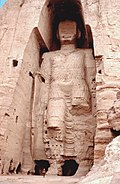Mullah Omar
Mullah Muhammad Umar[1][2] (1959 - 23 April 2013) was the founder of the Taliban in Afghanistan. He was usually called Mullah Omar. He came from a religious family of Islamic scholars near Kandahar. After Afghanistan was invaded by the Soviet Union in 1979, he joined the Afghan mujahideen to fight in the Soviet–Afghan War. He served as an important military general during several skirmishes, losing his right eye in an explosion. Between 1996 and 2001, he was Afghanistan's de facto head of state. Three states officially recognised him under the title of 'Head of the Supreme Council'. He was born in 1959 in Kandahar Province of Afghanistan.[3] He held the title Commander of the Faithful from the Islamic Emirate of Afghanistan.
Mohammed Omar مُلَّا مُحَمَّدٍ عُمَرَ | |
|---|---|
| Former Head of the Supreme Council of Afghanistan | |
| In office 27 September 1996 – 13 November 2001 | |
| Prime Minister | Mohammad Rabbani Abdul Kabir (Acting) |
| Preceded by | Burhanuddin Rabbani (President of Afghanistan) |
| Succeeded by | Burhanuddin Rabbani (President of Afghanistan) |
| Personal details | |
| Born | 1959 Kandahar Province, Afghanistan |
| Died | 23 April 2013 Zabul Province, Afghanistan |
| Political party | Islamic and National Revolution Movement of Afghanistan Taliban |
| Military service | |
| Battles/wars | Soviet-Afghan War Civil war in Afghanistan War in North-West Pakistan |
The United States put him on their most wanted list. They believe he sheltered Osama bin Laden, and some of his al-Qaeda group, directly before and after they committed the September 11 attacks.[4] He was believed to be directing the Taliban in their war against Hamid Karzai's Government and foreign NATO troops in Afghanistan.[5] Many people considered him to be a major terrorist.
Despite his political rank, and his high status on the FBI's wanted list,[4] not much was publicly known about Omar. There are very few photos of him. A picture that was used by the media in 2002, shows another Taliban official, but not Omar. It is also debated how authoritative the images that exist really are.[6]
Omar's right eye was missing as the result of a war wound. People described him as being tall.[7][8] He was described as shy and untalkative with foreigners.[6][9]
When he was Emir of Afghanistan, Omar stayed in Kandahar most of the time and rarely met outsiders.[7] He sent his Foreign Minister, Wakil Ahmed Muttawakil, to represent him, on most occasions.
News media claimed that he was killed by a drone strike in 2008.[10]
In 2012, it was revealed that an individual claiming to be Omar sent a letter to President Barack Obama in 2011, expressing slight interest in peace talks.[11][12]
Death
On 29 July 2015, the Afghan government and state intelligence sources said that Omar had died in April 2013 two years previously in Karachi, Pakistan, of tuberculosis. Some Taliban sources denied that he had died; other sources considered the report to be speculative, designed to destabilise peace negotiations in Pakistan between the Afghan government and the Taliban. A Taliban spokesman said that they would issue a statement.[13] Abdul Hassib Seddiqi, the spokesman for Afghanistan's National Directorate of Security, claimed: "We confirm officially that he is dead".[14]
It was later learned that he died in Afghanistan, not Pakistan.[15]
Mullah Omar Media
The June 15, 1998 letter from Mullah Omar to "all Taliban members young and old", complaining that his orders are not being followed. The letter was found in an al-Qaeda safe house in Kabul.
Mullah Omar ordered the destruction of the Buddhas of Bamiyan (pictured in 1976) in March 2001, receiving international condemnation.
Afghanistan opium poppy cultivation, 1994–2007 (hectares). Before the US invasion of Afghanistan in 2001, opium production was almost entirely eradicated (99%) by the Taliban.
References
- ↑ Azfar (2021-05-10). "Mullah Omar - On War and Peace". CAGE. Archived from the original on 2022-10-31. Retrieved 2022-10-31.
- ↑ Taneja, Kabir. "The Taliban has trumped the US in Afghanistan". ORF. Retrieved 2022-10-31.
- ↑ Rashid, Taliban, (2001) p.23
- ↑ 4.0 4.1 "Wanted Poster on Omar". Rewards for Justice Program. US Department of State. Archived from the original on 2006-10-05. Retrieved 2009-09-26.
- ↑ CNN.com - Source: Mullah Omar in Pakistan - Sep 9, 2006
- ↑ 6.0 6.1 Who is the real Mullah Omar? Daily Telegraph, 22 December 2001[dead link]
- ↑ 7.0 7.1 Griffiths, John, C. "Afghanistan: A History of Conflict", 1981. Second Revision 2001.
- ↑ Christian Science Monitor, The reclusive ruler who runs the Taliban
- ↑ Afghanistan: Taliban Preps for Bloody Assault, Newsweek, 5 March 2007
- ↑ 'US strike' kills Taleban leader. BBC News
- ↑ "Taliban leader Mullah Omar 'sent letter to Barack Obama'". The Daily Telegraph (London). 3 February 2012. https://www.telegraph.co.uk/news/worldnews/asia/afghanistan/9060564/Taliban-leader-Mullah-Omar-sent-letter-to-Barack-Obama.html. Retrieved 3 February 2012.
- ↑ Amid peace bid, U.S. received purported letter from Taliban. Reuters. 3 February 2012. https://www.reuters.com/article/2012/02/03/us-usa-afghanistan-taliban-letter-idUSTRE8121M520120203. Retrieved 3 February 2012.
- ↑ "Taliban conflict: Afghanistan probes Mullah Omar 'death' claim". BBC News. 29 July 2015.
- ↑ "Afghan intelligence: Taliban leader Mullah Omar dead". Archived from the original on 2015-07-29. Retrieved 2015-07-29.
- ↑ Emma Graham-Harrison (10 March 2019). "Fugitive Taliban leader lived short walk from US base, book reveals". The Guardian.
- Rashid, Ahmad (2001). Taliban: The Story of the Afghan Warlords. Pan Books. ISBN 0-330-49221-7.


